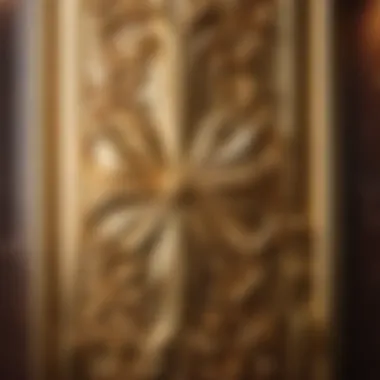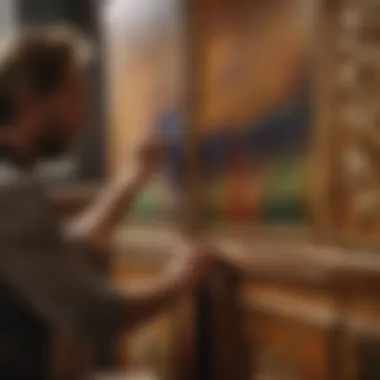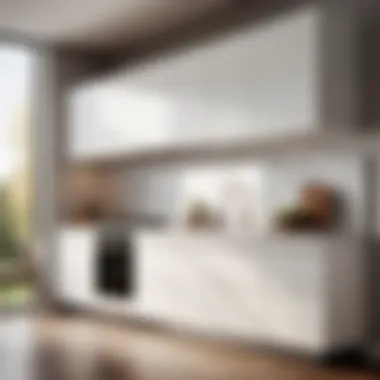Materials:
- Primer: 1 gallon of high-quality primer suitable for cabinets
- Paint: 2 gallons of premium paint specifically formulated for cabinets in desired color
- Sandpaper: 1 pack of 120-grit and 1 pack of 220-grit sandpaper
- Degreaser: 1 bottle of heavy-duty degreaser to clean cabinets
- Painter's Tape: 2 rolls of painter's tape to protect areas not being painted
- Paintbrushes: 1 pack of high-quality paintbrushes in various sizes
- Rollers: 2 paint rollers suitable for cabinet painting
- Drop Cloth: 1 large drop cloth to protect flooring
DIY Steps:
- Preparation: Remove cabinet doors, hardware, and clean surfaces with degreaser. Lightly sand cabinets to create a smooth surface for painting.
- Priming: Apply a coat of primer to cabinets, allowing it to dry completely before moving on to painting.
- Painting: Use a paintbrush or roller to apply the first coat of paint evenly. Let it dry before applying a second coat for full coverage.
- Drying & Reassembly: Allow painted cabinets to dry completely before reattaching doors and hardware.
Technical Aspects:
- Tools: Screwdriver, paint trays, tack cloth, and safety goggles
- Timing: Plan for at least a weekend to complete the cabinet painting project
- Techniques: Use long, even strokes when painting to prevent streaks and ensure a professional finish
DIY Project Process:


- Sequential Steps: Follow the steps in order: prep, prime, paint, and dry
- Troubleshooting Tips: If paint streaks appear, lightly sand areas and apply an additional coat for seamless coverage
Understanding Cabinet Painting Costs


In the realm of home improvement projects, painting cabinets stands out as a cost-effective and transformative way to revamp the aesthetics of a space. Understanding the various elements that contribute to cabinet painting costs is crucial for those embarking on this endeavor. This section will delve into the key factors that influence the overall pricing of cabinet painting, shedding light on important considerations that can impact the budget and outcome of the project.
Factors Impacting Cost
Material of Cabinets
The choice of material for cabinets plays a significant role in determining the cost of painting. Different materials such as wood, laminate, or MDF have varying levels of absorbency and durability, affecting the paint application process and the longevity of the finish. Hardwood cabinets, for example, are a popular choice due to their sturdy nature and ability to hold paint well, albeit at a higher initial cost. Understanding the material of cabinets helps in selecting the appropriate paint type and ensuring a smooth and lasting finish.
Size of the Project
The size of the cabinet painting project directly correlates with its overall cost. Larger cabinets or extensive cabinetry systems would require more paint, supplies, and labor hours, consequently increasing the total expenses. Smaller projects, on the other hand, might be more manageable in terms of cost and time investment. It's essential to assess the project's scale accurately to budget appropriately and prevent unexpected overruns.
Type of Paint Used
The type of paint selected for cabinet painting has a substantial impact on the final cost. High-quality paints with better coverage and durability typically come at a higher price point but may result in a longer-lasting and visually appealing finish. Understanding the characteristics of different paint types, such as oil-based or water-based paints, enables homeowners to make informed decisions based on their preferences, budget, and desired outcome.
Complexity of Design
The complexity of the design or desired finish intricacy can significantly influence the cost of cabinet painting. Intricate designs, patterns, or specialized techniques often require more time and expertise, thereby raising the overall project cost. Simpler designs or solid color palettes may be more cost-effective in terms of both materials and labor. Evaluating the design complexity beforehand helps in setting realistic cost expectations and ensuring that the project aligns with the envisioned aesthetics.
Preparatory Work Needed
Prior to painting cabinets, adequate preparatory work is essential to achieve a high-quality and long-lasting result. Tasks such as cleaning, sanding, priming, and repairing damages are critical in ensuring proper paint adhesion and a seamless finish. The amount of preparatory work needed can vary based on the existing condition of the cabinets, with neglected or damaged surfaces requiring more extensive restoration efforts. Understanding the level of preparatory work involved helps in planning the project timeline and budget effectively.
Calculating Painting Costs


Calculating painting costs is a pivotal aspect within the realm of cabinet painting projects. This section seeks to shed light on the intricate nature of estimating expenses associated with transforming cabinets through paint. By delving into the essential elements governing cost calculations, readers will gain a comprehensive understanding of the financial aspects involved in such endeavors. The meticulous breakdown of costs plays a crucial role in effective budgeting and project planning, ensuring that homeowners have a clear overview of the investment required for their cabinet painting venture.
Estimating Material Expenses
Cost of Paint
The cost of paint stands as a fundamental component in determining the overall expenditure linked to cabinet painting projects. This section focuses on elucidating the significance of selecting the appropriate paint type concerning quality, durability, and finish. Through an exploration of various paint options, readers will decipher the cost implications associated with premium versus standard paint selections. Additionally, emphasizing the role of paint in achieving the desired aesthetic appeal and longevity of the painted cabinets underscores its pivotal position in the budgeting process. Understanding the nuances of paint cost enables homeowners to make informed decisions aligning with their needs and preferences, contributing to a successful cabinet transformation endeavor.
Additional Supplies
Alongside paint, additional supplies play a crucial role in the cabinet painting process, complementing the overall cost estimation. This subsection delves into the necessity of various supplies such as brushes, rollers, primers, and sandpaper, elucidating their contribution to the final budget projection. By outlining the unique characteristics of each supply item and discussing their advantages in facilitating an efficient painting process, readers will grasp the importance of including these elements in their material expense calculations. Furthermore, weighing the advantages and potential drawbacks of different supply choices equips homeowners with the insights needed to optimize their material procurement strategy, ensuring a seamless cabinet painting experience.
Labor Charges
In the realm of cabinet painting, labor charges constitute a significant portion of the overall project cost. This section examines the implications of hourly rates in engaging professional painters versus opting for do-it-yourself approaches. By elucidating the factors influencing hourly rates and their impact on the budgeting process, readers can make informed decisions regarding the most suitable labor option for their painting project. Additionally, exploring the concept of flat project fees offers insights into alternative pricing structures, allowing homeowners to assess the cost-effectiveness of different labor arrangements. Understanding the dynamics of labor charges is essential in creating a realistic budget plan that aligns with the desired level of professional involvement in the cabinet painting journey.
Total Cost Projection
The total cost projection section aims to provide readers with a comprehensive overview of the financial considerations encompassing a cabinet painting project. Through sample calculations and cost breakdowns, homeowners can anticipate the total investment required for their painting endeavor. By addressing the nuanced aspects of budget estimation and forecasting potential expenses, this segment equips readers with the tools necessary to formulate a detailed and accurate budget plan. The in-depth analysis of sample calculations offers practical insights into cost allocation, enabling homeowners to prioritize expenditures and make informed financial decisions. By exploring different cost projection scenarios, readers can tailor their budgeting strategies to align with their desired outcomes, fostering a successful and cost-effective cabinet painting experience.
Budgeting Strategies for Cabinet Painting
In the realm of cabinet painting, budgeting strategies play a pivotal role in ensuring a successful and cost-effective project. When embarking on a cabinet painting endeavor, it is essential to have a well-thought-out budgeting plan in place to manage expenses efficiently and maximize resources. Budgeting strategies form the core foundation that guides homeowners through the financial aspect of the painting process, allowing for a smoother experience from start to finish.
Budgeting strategies for cabinet painting encompass a range of elements that aim to streamline costs while maintaining quality and aesthetics. From estimating material expenses to negotiating labor charges, implementing effective budgeting strategies can lead to significant savings without compromising on the overall outcome of the project. By carefully planning and organizing the financial aspects of cabinet painting, homeowners can achieve their desired results within a manageable budget.
Cost-Saving Tips
DIY Recommendations
When it comes to cost-saving in cabinet painting, DIY recommendations stand out as a popular choice for homeowners looking to reduce expenses without sacrificing quality. DIY painting allows individuals to take charge of the project, eliminating labor costs associated with hiring professionals. By opting for a hands-on approach, homeowners can save substantial amounts while also gaining a sense of accomplishment from completing the task themselves.
DIY recommendations offer the unique advantage of providing homeowners with full control over the painting process, allowing for customization and personalization based on individual preferences. While DIY painting requires time and effort, the cost savings and satisfaction derived from a successful DIY cabinet painting project make it a worthwhile endeavor for those willing to invest their energy into the task.
Negotiation Techniques
Negotiation techniques play a crucial role in securing favorable deals and discounts when engaging with suppliers, painters, or contractors for a cabinet painting project. By skillfully negotiating prices and terms, homeowners can leverage their bargaining power to obtain cost-effective solutions and maximize their budget allocation. Effective negotiation techniques can lead to substantial savings, allowing homeowners to stretch their budget further and potentially invest in higher-quality materials or finishes.
Implementing negotiation techniques requires a strategic approach, clear communication, and a willingness to explore different options to achieve the best possible outcome. By mastering the art of negotiation, homeowners can unlock hidden savings, capitalize on opportunities for discounts, and enhance the overall cost-efficiency of their cabinet painting project.
Expert Insights on Cabinet Painting Prices
In this in-depth guide on cabinet painting costs, it is crucial to delve into expert insights to provide readers with a comprehensive understanding of the pricing dynamics involved in this home improvement project. Expert insights offer a distinct advantage by shedding light on nuanced considerations that can impact the overall cost of painting cabinets. By tapping into the knowledge and experience of professionals in the field, readers gain valuable information that goes beyond surface-level estimations.
Industry Professional Opinions
Interviews with Painters
Unveiling the specific aspect of interviews with painters adds a unique dimension to this article. These interviews serve as a cornerstone in providing first-hand perspectives from individuals deeply immersed in the cabinet painting industry. By showcasing the thoughts and experiences of painters, readers can grasp real-world challenges, cost factors, and optimal practices prevalent in the field. The key characteristic of incorporating interviews with painters lies in the authenticity and practical relevance it brings to the discussion. Through these interviews, readers are exposed to a plethora of insights that help in making informed decisions when undertaking a cabinet painting project.
Guidance from Home Renovation Experts
Exploring the guidance from home renovation experts introduces a layer of expertise that enriches the overall narrative. With a focus on insights from professionals well-versed in the renovation domain, this section offers invaluable advice and strategic recommendations. The key characteristic of integrating guidance from home renovation experts lies in the strategic and calculated approach to tackling cabinet painting projects. By tapping into their specialized knowledge, readers can navigate through cost-effective solutions, quality considerations, and long-term implications of their painting decisions.
Consumer Experiences
Testimonials on Costing
Diving deep into consumer experiences through testimonials on costing provides a humanistic angle to the discussion. By showcasing real-life accounts of individuals who have undergone cabinet painting projects, readers can draw parallels, expectations, and insights based on these testimonials. The key characteristic of including testimonials lies in the relatability and trust it builds with the audience. Through these testimonials, readers can gauge the practical implications of different cost scenarios, vendor selections, and project outcomes, enriching their understanding and decision-making process.
Future Price Trends
Predictions and Forecasts
Exploring future price trends through predictions and forecasts is essential in helping readers plan for their cabinet painting projects effectively. By delving into upcoming trends and potential shifts in pricing dynamics, readers can preemptively strategize their budgets and timelines. The key characteristic of predictions and forecasts lies in the forward-thinking approach it instills in readers. By being aware of possible price fluctuations and market trends, individuals can make informed decisions that align with their long-term goals and financial considerations.





